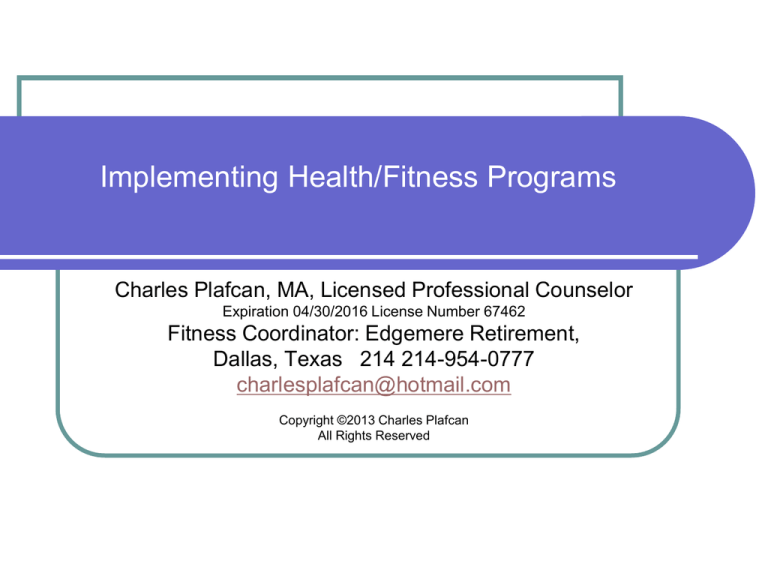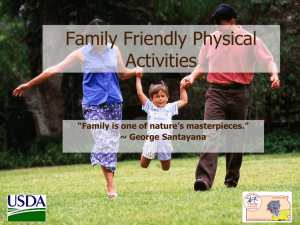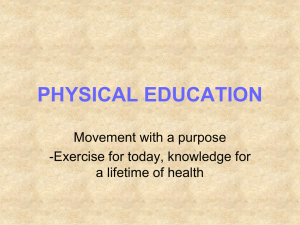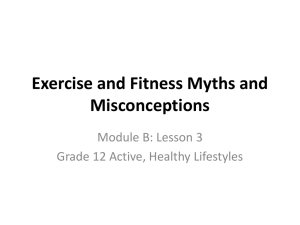
Implementing Health/Fitness Programs
Charles Plafcan, MA, Licensed Professional Counselor
Expiration 04/30/2016 License Number 67462
Fitness Coordinator: Edgemere Retirement,
Dallas, Texas 214 214-954-0777
charlesplafcan@hotmail.com
Copyright ©2013 Charles Plafcan
All Rights Reserved
Charles Plafcan LPC
MA Professional Counseling (2010),
Licensed Professional Counselor Expiration 04/30/2016 License Number 67462
MA in Human Relations and Business (1994)
LPC/Fitness Coordinator Edgemere (2007 to present)
Bachelor of Arts in Psychology (1992)
ACE (American Council on Exercise) Group Fitness Instructor
and ACE Personal Trainer
Sweatshop Aerobic Studio Owner (1989)
Waist Basket Aerobics Studio, Houston, Texas,
Instructor Trainer
Responsible for opening 5 Aerobic Studios in Dallas
Health/Fitness Programming
Increases the well-being of participants through
Planned health education and fitness experiences
Achieve higher levels of health while preventing
disease
Improve the psychological atmosphere of communities
Individualized health/needs assessments,
Scientifically correct and safe exercise techniques
Health/Fitness Programming:
continued
Customized programming
Support services such as health counseling and
regular group exercise classes
Promote fitness experiences
Facilitate health/wellness behavioral change and
adherence techniques
Leadership: Fitness/Wellness Program Director
Promotes positive image of good health and fitness, “Role model
of Fitness”
Has most influence on success of program, Provides the
interface between the program and participants
Exercise leaders should be enthusiastic motivators with a positive
attitude, persistent energy, ability to organize and lead exercise
classes, use music and choreograph routines
Must be an effective counselor, good listener, establishing rapport
through confidence and genuine concern for the participants
Organize and promote educational opportunities for residents and
families.
Dimensions of Wellness
Physical
Engaging in at least 30 minutes of physical activity on most days and other
preventative approaches
Emotional
Being happy, sharing with others, and engaging in positive actions and thoughts.
Social
Interacting with family, friends, and others in fun activities that stimulate the mind,
body and spirit.
Intellectual
Encouraging a cognitive mind through various fun activities such as problemsolving, critical thinking and creativity.
Spiritual
Valuing, believing and living spiritual beliefs every day, or finding inner peace
through thoughtful exercises such as meditation.
Vocational
Yearning to learn new ideas, hobbies, philosophies, skills, and being well
informed.
Wellness Wheel
Intellectual
Physical
Social
Personal
Wellness
Spiritual
Emotional
Vocational
Traditional Programming
Health-based Fitness
Aerobic Capacity
Muscular Endurance
Muscular Strength
Flexibility
Body Composition
Nutrition
Weight Management
Where we’re Going… The Evolution of Fitness and
Wellness
Behavioral Based: Seek behavior change in clients,
help and encourage to persevere
Experience Based: “enjoy the doing”, the “getting
someplace” as much as the goal or the “arriving”
Understand the evolving needs and concerns of the
aging client’s fitness experience
Psychological Based: Self motivation (or its
absence), Life satisfaction, Happiness, Self-efficacy,
peer encouragement, boost self esteem, pleasure and
sociability—not effort and hard work
The Evolution of Fitness and Wellness
One-dimensional Approach Shift:
Multi-dimensional Approach
Physiological
Cognitive
Physiological
Emotional
Fitness Professionals Expanded Scope of Practice
Now facing many special needs
Metabolic (raise the metabolism)
Musculoskeletal (strength training for frail and deconditioned)
Post-rehabilitation (take care of clients after physical
therapy)
Functional Training (training the body for the activities
performed at home in daily life)
Aging
Obese
What we Need to Consider
Personal Attributes: (Belief systems, age, experiences,
etc.)
Environnemental Factors: (Convenience, support, etc.)
Physical Activity Factors: (Injury, tolerance, etc.)
Choices: Cognitive (Thinking)
Emotional Factors: (Feeling)
Decisions and Choices: (Thinking)
What we Need to Consider
Shift focus to create positive, engaging and
memorable experiences
“Promote the experience and you can virtually
guarantee yourself participation and higher retention
rates”
-Thomas Plummer
Early Cognitive Influences: exercise adherence
Improved self-efficacy with task accomplishment
set challenging, yet manageable tasks
Leverage any positive emotional experiences
Self-efficacy
A belief in one’s own capabilities to complete a task.
The more capable one feels regarding their ability to
engage in activity, the more likely they are to adhere.
Past performance and experiences -most influential
Emotional states or responses
Physiological and emotional states or responses
Rapport = Relationship based on trust &
communication
Engagement: emotional involvement or commitment
Skillfully develop professional relationships
Strategically adapt to different personality styles
Successfully promote behavioral change strategies
Create an overall positive experience for clients
Optimize training to an individual’s unique needs,
goals and characteristics
Perception is Reality
Identify Readiness to Change
Implement Appropriate Behavioral Strategies
Build Self-Efficacy
Achieve / Promote Positive Behavioral Change
Utilize strategies to Prevent Lapses
Four Founding Principles
Empathy
Discrepancy (between current and with change)
Self-efficacy
Acknowledge / overcome ambivalence / resistance
Older Adults and Exercise
The Top 20 fitness Industry trends for 2015:
American College of
Sports Medicine’s (ACSM)
#8. Fitness Programs for Older Adults: create age-appropriate
fitness programs to keep older adults healthy and active
#9. Functional Fitness and special fitness programs taylored to
the needs of older adults
#10 Group Fitness “Healthy support groups will become a more
popular offering in fitness settings due to peer encouragement
and increased potential for success. The majority of older adults
will seek group classes to stay fit.”
What is the Successful Aging?
Successful aging is a lifestyle that maximizes function
and productivity.
Actively seeks ways to enhance the physical, mental,
social and spiritual components of our lives
Promote the client’s independence
Development of a fitness/wellness plan around each
resident's individual desires and goals
MacArthur Foundation: study on aging aging
shattered the stereotypes of aging
landmark 8-year study (1988-1996)
70% of physical aging, and about 50% of mental
aging, is determined by lifestyle
it's possible to live long without significant disability
maintain physical and mental skills
reduce our risk for disease and injury
stay productive and engaged in life
Personal Wellness : All Properties contribute & benefit
Edgemere
Dallas
Resident
focused
One
uniform
program
Personal
Wellness
everyone
contributes
Control
cost
Ease of
training
All Properties contribute & benefit
Maximize Profit Potential
Resident focused
Resident’s perceive more choices (portability)
Control cost with one uniform program
Ease of employee training
Everyone contributes from the Residents to the
Employees
Fitness/Wellness Director implements through key
personnel
SQLC communities: pulling it all together
SQLC communities to be on the cutting edge of
Fitness and Wellness
Implement one Fitness/Wellness plan for all SQLC
communities that is monitored by the Fitness/Wellness
Director
Begin with one program at a time (ex. Exercise,
Nutrition) and progress the wellness plan from there
Designate key personnel at each site to implement
SQLC communities: pulling it all together
Training manuals
Fitness/Wellness Program at each SQLC community
structured so fluctuations in employment has no
impact
Implement Program standardization and uniformity
where any new employee can step in and know what
is needed to be done
SQLC communities: pulling it all together
For the Fitness Instructors
Conduct Instructor Training sessions to make the
program uniform through all SQLC communities
Talk the same Talk, Walk the same Walk
Fitness Instructor evaluation by Fitness/Wellness
Director
Hands on approach with Fitness Instructors, have
them practice doing what they are teaching
Certify and Train Staff
The Top 20 fitness Industry trends for 2015:
CERTIFICATIONS professionals certified through programs
that are accredited by the National Commission for Certifying
Agencies (NCCA)
American College of Sports Medicine (ACSM)
The need for Educated and Experienced Fitness
Professionals
Physical Activity
1st phase
of the plan
Why Is Physical Activity Such a Big Deal?
Big Deal? Regular exercise and physical activity
Being physically active can help you continue to do the
things you enjoy and stay independent as you age
can produce long-term health benefits
can reduce the risk of developing some diseases and
disabilities that develop as people grow older
an effective treatment for many chronic conditions
Older adults should do exercises that maintain or
improve balance if they are at risk of falling
Big Deal? Regular exercise and physical activity
Older adults should determine their level of effort for
physical activity relative to their level of fitness
Older adults with chronic conditions should
understand whether and how their conditions affect
their ability to do regular physical activity safely.
Exercise Programming:
Sample implementation and how it
has a significant impact on wellness
Needs Assessment : individual consultation, health
screening questionnaires, exercise testing of
cardiovascular and muscular endurance, strength,
flexibility,
Service Component
Evaluation: post exercise
testing, check their record
keeping, questionnaires on
the program’s effectiveness
Implementation: individual
counseling, teach them the
equipment, regular group
exercise classes, special group
classes for special populations
Discuss exercise goals:
present and long-term
Education Component
Planning: Education
materials, record keeping,
progress monitoring
Nutrition and Weight Management
2nd phase of
the plan
Following a healthy eating plan and being
physically active are keys to a healthy
lifestyle
Older Adults: 65 years and older
Achieving and sustaining appropriate body weight
across the lifespan is vital to maintaining good health
and quality of life
Older adults should follow the food pyramid and
dietary guidelines for adults.
When older adults cannot meet the adult guide-lines,
they should be as physically active as their abilities
and conditions will allow
Basic Nutrition:
Sample implementation and how it has a
significant impact on wellness
Needs Assessment : individual consultation,
determine the resident’s current nutritional status.
Observe, take body measurements, do a dietary
intake
Service Component
Evaluation: discuss new
eating habits, reassess body
composition after 3 months,
Director must be positive and
sympathetic
Implementation: each participant
to keep a food diary, education of
the food pyramid and dietary
guidelines, encourage little
changes at a time
Goals: Counseling to set
appropriate and realistic goals,
individualized guidelines of eating
correctly
Education Component
Planning: teach creative methods
for diet improvement, Group
Education, encouragement,
progress monitoring
Duties and Skills: Fitness/Wellness Director
Prepare preliminary departmental Operating Budget
Responsibilities include: interviewing, hiring, and training
employees; planning, assigning, and directing work;
Appraising performance; rewarding and disciplining employees.
Responds promptly to resident needs.
Must demonstrate an interest in working with a senior population.
Interacts with guests, residents and staff in a courteous and
friendly manner
Profile of Fitness/Wellness Director
These would include experience and knowledge of:
Adult fitness
Exercise Leadership
Behavior modification
Human relations
Personnel management
Health behavior
Health/Wellness Counseling
Human motivation theory
Human movement theory
Human anatomy
Public Relations
Sample Organizational Structure: Medical Department
Medical Department
Physicians
Psychologist
Fitness/Wellness Director
Health Educator
Nurses
Exercise Specialist
Nutritionist
Recreation Specialist
Sample Organizational Structure: YMCA Fitness/Wellness
Large YMCA
Executive
Director
Fitness/Wellness
Director
Health Enhancement
Program Director
Sports/Recreation
Program Director
Sample Organizational Structure: Private Health Care Facility
Chief Executive
Officer
Medical
Director
Education
Consultant
Director
Fitness/Wellness Director
Fitness/Wellness Program
Delivery
Implementing Health/Fitness Programs
Charles Plafcan, MA, Licensed Professional Counselor
Expiration 04/30/2016 License Number 67462
Fitness Coordinator: Edgemere Retirement,
Dallas, Texas 214 214-954-0777
charlesplafcan@hotmail.com
Copyright ©2013 Charles Plafcan
All Rights Reserved
References
Fabio Comana, MA., MS.,Exercise Physiologist – The ACE
Integrated Fitness Training (IFT©) Model Director of Continuing
Education, National Academy of Sports Medicine (NASM).
Sara Kooperman, JD, CEO SCW Fitness Education (Dallas
Mania), Our Fitness Future: Fad or Function (lecture).
National Institute on Aging, National Institutes of Health, U.S.
Department of Health and Human Services, Exercise & Physical
Activity, Your Everyday Guide
Patton, R., et al. Implementing Health/Fitness Programs:
Champaign, Illinois: Human Kinetics Publishers, Inc., 1986
U.S. Department of Agriculture U.S. Department of Health and
Human Services : Dietary Guidelines for Americans 2010







